
Coping with Anesthesia
Neuromuscular disorders pose special risks, but preparation minimizes dangers
Wendy Hinton says she "still gets goosebumps" when she thinks about the morning of Oct. 25, 1989.
She and her husband, Doug, had brought their 2-year-old son, Shayne, to St. Anthony's Central Hospital in Denver to have a routine procedure that doctors thought might help the child's frequent ear infections and difficulty breathing through his nose.
But, less than 15 minutes later, something went terribly wrong.
"We saw red lights flashing, alarms going off, people with machines running down the hall," Wendy says. "My husband and I stepped out of the room to see what was going on, and nurses came and pushed us back in."
Over the next 45 minutes, which Wendy describes as "the worst of our lives," the hospital staff supplied the Hintons with a priest, two crisis counselors and a telephone. Shayne, they were almost certain, wasn't going to make it.
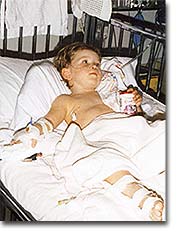 Once-deadly syndrome now under better control
Once-deadly syndrome now under better control
Thanks to persistent resuscitation efforts, Shayne Hinton is alive today. After recovering from his near-death in the operating room, the child was found to have experienced a rare but extremely dangerous reaction to anesthesia drugs known as malignant hyperthermia (MH). (It means "seriously high temperature.")
He was also found to have Duchenne muscular dystrophy, one of many conditions that doctors now say may increase the risk of malignant hyperthermia reactions.
In the 1960s, surgical teams first began to recognize and name this condition in which, shortly after receiving general anesthetic agents, surgical patients began to go downhill. Patients became stiff instead of relaxed, their body temperatures soared, sometimes to as high as 110 degrees, and their metabolic processes became so abnormal that they usually didn't survive.
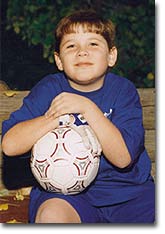 Later research found the source of the problem: In MH-susceptible people, muscle cells react in an unusual way to some of the most commonly used drugs in the operating room. Inside these cells, a molecular gate opens and stays open, allowing an excessive and uncontrolled release of calcium, when MH-susceptible people are given commonly used inhalational agents (such as halothane, enflurane and isoflurane), especially if they're combined with a muscle-relaxing drug called succinylcholine.
Later research found the source of the problem: In MH-susceptible people, muscle cells react in an unusual way to some of the most commonly used drugs in the operating room. Inside these cells, a molecular gate opens and stays open, allowing an excessive and uncontrolled release of calcium, when MH-susceptible people are given commonly used inhalational agents (such as halothane, enflurane and isoflurane), especially if they're combined with a muscle-relaxing drug called succinylcholine.
This excessive calcium release causes muscles to contract continuously and generates a massive amount of heat, enough to disrupt almost every body process.
"The mortality rate from MH in the 1960s was 70 percent," says Gerald Gronert, who recently retired as professor of anesthesiology at the University of California at Davis. "It's probably less than 5 percent now."
The marked decrease in MH mortality is the result of better preoperative testing, better monitoring during surgery, the use of "nontriggering" anesthetic agents for at-risk patients and, perhaps most importantly, the development of a drug called dantrolene. This drug, a specific antidote for MH, stops the flow of calcium from inside muscle cells and "turns off" the reaction.
Recent research has found that, while nearly everyone with a neuromuscular disease may have a slightly increased risk of developing MH during surgery, the highest risk occurs in people with central core disease, a disorder that specifically involves an abnormality in calcium regulation inside muscle cells.
Estimates of the incidence of MH reactions in the United States during anesthesia range from 1 in 65,000 people to 1 in 5,000, when special risk factors aren't taken into account. The risk for people with muscular dystrophy and related disorders remains uncertain.
If you're planning surgery for yourself or a child and have a neuromuscular disorder in the family, talk to your doctor. Information about testing for MH susceptibility can be obtained from the Malignant Hyperthermia Association at www.mhaus.org or (800) 986-4287.
Beyond MH
The good news, for the Hintons and thousands of other families, is that MH is far better understood and controlled today than ever before.
The bad news is that many more anesthesia-related troubles have been discovered for people with neuromuscular disorders.
Normal Neuromucular Junction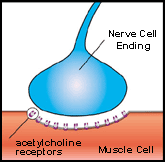
At a normal neuromuscular junction, a nerve cell transmits chemical signals that float across a microscopic space and dock on acetylcholine receptors on a muscle cell. |
Myasthenia Gravis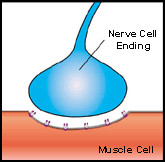
At a neuromuscular junction in myasthenia gravis, there are fewer than the usual number of acetylcholine receptors on the muscle cell. Therefore, a large percentage of them can be blocked by a muscle-relaxing drug, leading to temporary paralysis. |
Malignant Hyperthermia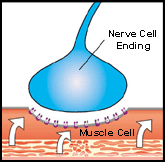
At a neuromuscular junction in malignant hyperthermia, a molecular gate deep inside the muscle cell stays open, releasing a dangerously large amount of calcium into the cell. |
SMA and ALS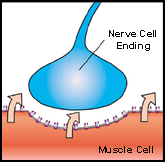
At a neuromuscular junction in spinal muscular atrophy or amyotrophic lateral sclerosis, an abnormal nerve cell can fail to transmit signals to a muscle cell. In response, the muscle cell sprouts many new acetylcholine receptors. When these are activated by a muscle-relaxing drug, a dangerously large amount of potassium can be released from inside the muscle cell. |
"I think it would be a mistake for either the patient or the anesthesiologist to fixate on malignant hyperthermia as the most important issue with neuromuscular disease," says Harvey Rosenbaum, anesthesiologist and co-director of the Malignant Hyperthermia Program at the University of California at Los Angeles.
For one thing, many people with neuromuscular conditions have associated respiratory or cardiac impairment, something that makes surgery and anesthesia more complicated and which has to be carefully evaluated and prepared for before any surgical procedure.
For another, people with muscle disorders may simply have more fragile muscles, subject to breaking down under stress. The stress of surgery itself, of lying in an awkward position with one part of the body pressing on another (necessary in some procedures), of having a tourniquet applied during an operation, of experiencing postoperative shivering, may all contribute to complications in some patients, experts say.
Then, too, many drugs used for anesthesia act on cell membranes, thin coverings that surround each cell. Since many neuromuscular disorders involve abnormalities in these membranes, it's not too surprising that drug-membrane interactions in neuromuscular disorders could go wrong.
Orthopedic surgeon Irwin Siegel, who co-directs the MDA clinic at Rush-Presbyterian-St. Luke's Medical Center in Chicago, recommends that the surgical team be well versed in the patient's neuromuscular disorder and preferably well practiced in doing surgery on such patients.
His advice: "not to avoid surgery, but to make sure you're in a situation where your risks are as well covered as humanly possible." That may include asking your surgeon some tough questions, Siegel says, and sometimes postponing surgery until you can get to a major medical center.
Siegel tells his patients, "If you ever have a fracture, go to the emergency room and have them call me. If you have an operation, it shouldn't be done at a local hospital by someone who doesn't have experience treating your particular illness."
Trouble where nerve meets muscle
Modern anesthesia actually uses a combination of drugs. Most of these drugs have multiple actions, but each has a principal action: to induce unconsciousness, relieve pain or relax muscles (this last being required in varying degrees depending on the nature of the operation).
The muscle-relaxing drugs act at the neuromuscular junction, the place where nerve and muscle meet and where nerve cells transmit chemical signals that float across microscopic spaces and "dock" on muscle cell membranes at specific sites known as acetylcholine receptors (see illustration above).
After this docking, submicroscopic gates known as ion channels open in the thin membrane covering each muscle cell. Sodium and calcium ions flow into the cell, potassium flows out, and then gates deeper inside the cell release calcium into the interior - the final step that lets tiny filaments slide over each other, which is the molecular foundation of muscle contraction.
What happens when an abnormal neuromuscular junction meets a chemical muscle relaxant can sometimes be unexpected — and unfortunate.
In myasthenia gravis, for instance, there are too few acetylcholine receptors on the muscle side of the junction, because these docking sites are destroyed by the body's immune system in this autoimmune disorder. When people with MG are given the usual dose of any of several drugs designed to block a certain percentage of acetylcholine receptors and cause muscle relaxation, they may have so few receptors left that virtually all of them are blocked. Such a blockade can lead to total (though temporary) paralysis, including cessation of the muscle activity required for breathing. These muscle relaxants are known as non-depolarizing. This group includes almost all relaxants except succinylcholine.
Among the most serious reactions to a muscle relaxant, however, are those found in people with spinal muscular atrophy (SMA) and amyotrophic lateral sclerosis (ALS), diseases in which the nerve cells that normally control muscles (motor neurons) are lost and signals from nerve to muscle are diminished or absent.
SMA and ALS are denervation (loss of nerve) syndromes. When a muscle cell loses the signal it expects to get from a nerve cell, it begins to sprout new acetylcholine receptors, Gronert explains. It's as if the muscle is making a last-ditch effort to reach out to a nerve cell that's no longer transmitting signals.
Without signals from nerves, muscles eventually die, too, becoming scarred and weakened. When that happens, Gronert says, there usually isn't much problem with anesthesia drugs. (In fact, not much medication, if any, is needed to relax muscles that are already this weakened.) It's in the early stages of a denervation disorder, when the muscle cells are still reaching out to the nerve, that trouble occurs.
Normally, Gronert says, when people are given the drug succinylcholine to relax muscles, a little bit of potassium from inside the muscle cells leaks out into the bloodstream. This is because succinylcholine, like its cousin acetylcholine, docks on the receptors and opens some gates in the cell, letting certain molecules flow in and out.
Normally, this poses no problem. But when there has been a massive increase in the number of receptors on muscle cells, succinylcholine "interacts with all those receptors, and they all release potassium," Gronert says. If the potassium level in the blood gets high enough, heart rhythm is disturbed. Extremely high potassium levels can stop the heart, something Gronert says can happen in SMA or ALS patients unwittingly given succinylcholine.
"The amount of potassium coming out [of the cells] can be large and life-threatening," he says. The solution: not to use succinylcholine in motor neuron disorders.
Trouble at the gates
In a group of disorders known as periodic paralyses, ion channels that normally open when acetylcholine docks on membrane receptors don't function normally, and people experience temporary paralysis attacks in response to a variety of dietary, exercise, stress-related and other environmental changes.
After surgery, "many patients [with periodic paralysis] say, 'I woke up in the recovery room and I couldn't move; I didn't get my full strength back for four or five days,'" says Louis Ptacek, a neurologist at the University of Utah in Salt Lake City.
Ptacek emphasizes that the exact cause of the prolonged paralysis with anesthesia in some people with periodic paralysis isn't known and that it could be the stress of the surgery and/or any of the anesthetic drugs. One thing is critical for the medical team, he says: to distinguish between a periodic paralysis attack and an MH reaction. The treatments are completely different.
Certain other muscle conditions, such as myotonic muscular dystrophy (MMD) and myotonia congenita (MC), involve an inability to relax muscles at will (myotonia). The problem is usually traceable to faulty action of ion channels in the muscle cells (although the connection in myotonic dystrophy isn't entirely clear).
When certain drugs, particularly the muscle relaxant succinylcholine, are used, "these patients become rigid instead of relaxing," says Christopher Viscomi, an anesthesiologist at the University of Utah. That, he says, can complicate some procedures and make it harder than usual to put a patient on a ventilator.
If muscle relaxation during surgery is needed in people with periodic paralysis or myotonia, care must be taken with the choice of relaxing agent.
The anesthetic risks in myotonic dystrophy go far beyond inability to relax muscles with drugs. People with this disorder seem to have an especially high incidence of trouble with anesthesia in general for reasons that aren't well understood.
Fragile muscles break down under stress
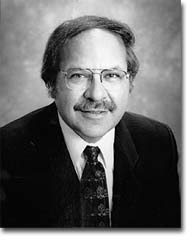 If the stress of surgery itself, awkward positions on the operating table and tourniquets that impair blood flow weren't enough for a person with fragile muscles to endure, there are also some threats to such muscles from anesthetic agents.
If the stress of surgery itself, awkward positions on the operating table and tourniquets that impair blood flow weren't enough for a person with fragile muscles to endure, there are also some threats to such muscles from anesthetic agents.
"A lot of people consider that patients with muscular dystrophy are susceptible to malignant hyperthermia," says Henry Rosenberg, an anesthesiologist at Thomas Jefferson University in Philadelphia. In his opinion, what they often have is something that looks like MH but really isn't.
Instead, he says, they have "some kind of muscle breakdown syndrome" that occurs with certain anesthetic drugs.
Early in the 1990s, Rosenberg says, "we began to be aware that when patients with Duchenne and Becker muscular dystrophies, and maybe some of the other muscular dystrophies, were exposed to succinylcholine and inhalational agents, their muscle membranes became leaky. "The way we knew this is that patients would develop very high potassium levels and have cardiac arrests. At first, we thought it was the succinylcholine. Most of [the patients] were children, and it was not clear that they had muscular dystrophy, because they were too young to have manifested symptoms."
Like Shayne Hinton, now 13, many of these patients were later found to have muscular dystrophy, Rosenberg says. A few years ago, the Food and Drug Administration required the manufacturers of succinylcholine to warn anesthesiologists not to use the drug on patients suspected of having a muscle disorder.
Unfortunately, says Rosenberg, eliminating succinylcholine from the anesthesia regimen didn't solve all the problems it was expected to.
"More recently, we found out that if people with muscular dystrophy receive any of the malignant hyperthermia-triggering agents, even without succinylcholine, they can also get into problems."
The problems, in addition to life-threatening potassium levels, can include the release of large proteins, such as myoglobin, from the inside of the muscle cells, as the cells break down and membranes become massively leaky. These large proteins can damage the kidneys.
It isn't clear that dantrolene can help in this muscle breakdown syndrome, Rosenberg says. He suggests that it be treated by regulating potassium levels with solutions of glucose and insulin, and minimizing the damage from the myoglobin with lots of intravenous fluids.
But the best treatment, he says, is prevention — not giving MH-triggering agents to people with muscular dystrophy, actual or suspected — in the first place.
Good anesthetic alternatives
"There are excellent alternative anesthetics that can be given," says Jordan Miller, anesthesiologist and director of the Malignant Hyperthermia Program at the University of California at Los Angeles. Rosenbaum, who co-directs that program, says he and Miller always encourage people to be honest about their concerns because there are almost always solutions to an anesthesia problem.
Succinylcholine can be avoided by using other muscle relaxants, if such drugs are needed.
And, Rosenbaum says, "We're quite capable of doing without potent inhalational agents."
He says the gas nitrous oxide and several intravenous agents can be safely used in the presence of a neuromuscular disease. Many people ask Miller and Rosenbaum about "local" anesthesia, the kind usually used for dental procedures or sewing up a wound, and "regional" anesthesia, the kind used to numb large areas of the body (for example, in labor and delivery).
The drugs used for local and regional numbing of an area affect signal transmission along nerves and are usually all right for people with neuromuscular conditions. However, Rosenbaum says, because nerves are affected by these drugs, "most practitioners are a little gun-shy about using them in patients with peripheral neuropathies." (Charcot-Marie-Tooth disease, Dejerine-Sottas disease and Friedreich's ataxia fall into this category.)
Miller says the real challenge is to make sure local or regional anesthetics are used properly and that a technique isn't being "pushed be-yond its normal use" just because either the patient or the doctors are afraid of using general anesthesia.
When that occurs, he says, the anesthetic is sometimes found to be inadequate for the procedure. The anesthesiologist may keep giving the patient more narcotics or other systemic drugs to compensate, which, he says, "can be a disaster.
"The issue is not so much that you can or can't use regional anesthesia, but you have to use it where it's appropriate, where the anesthesiologist and the surgeon think it would work well for that procedure," Miller says.
One place where regional anesthesia may be especially appropriate is in the woman with periodic paralysis who's having a baby, Viscomi says.
Viscomi says he and Ptacek treated a woman with this disorder during her pregnancy and childbirth, and epidural anesthesia (a regional anesthetic injected into the fluid around the spinal cord) was an excellent choice for her. Viscomi says it probably would be for most women in that situation.
"Strenuous muscle activity, both voluntary and involuntary, is associated with the onset of a periodic paralysis attack," Viscomi says.
He notes that epidural anesthesia reduces the work of labor by about 50 percent, thus reducing the risk of a periodic paralysis attack and avoiding the risks of general anesthesia at the same time. Epidurals can also often be used for Caesarean deliveries, Viscomi adds.
Communication, preparation, monitoring
Perhaps the great decrease in mortality rates associated with anesthesia has come about in recent years because of the marked increase in high-tech monitoring of patients during surgery. Today, sophisticated devices can continuously check a patient's temperature, exhaled carbon dioxide, blood oxygen concentration, blood potassium or sodium levels, electrical activity of muscles, and many other body functions.
The use of some of these devices is now routine, but some procedures depend on the surgical team's awareness and preparedness for specific problems — which is where patient responsibility comes into play.
When surgical teams have been thoroughly briefed about a patient's condition, they can take many precautions that otherwise might not have occurred to them - such as changing the patient's position on the table or minimizing shivering after surgery.
Unfortunately, it may fall to the patient and family to ensure that such briefing takes place. "I would recommend to the patient or the patient's family, if a child is involved, that they schedule a meeting with the anesthesiologist well ahead of time," Rosenbaum says.
"The anesthesiologist should look over a recently updated summary from the patient's primary care physician, such as the pediatrician or internist, as well as the patient's neurologist, to have a very good understanding of the patient's condition," he says. "This should cover not only how it affects the neuromuscular system, but what other organ systems are affected, how it affects day-to-day functioning, and how it might impact the patient during surgery and in the early postoperative period.
"I think serious problems are relatively uncommon if one is educated about patients and can anticipate problems and minimize the likelihood of their occurrence."
Miller agrees. "I think the biggest problem is that patients frequently depend on surgeons to adequately convey information to the anesthesiologist, but that should not be depended on," he says.
"The patient should have direct communication, preferably with the anesthesiologist who's going to be taking care of them, but, if not, then with some member of the anesthesiology department, so that the whole anesthesia can be planned."
Just knowing the patient's neuromuscular disease diagnosis isn't nearly enough, Miller says. "Where the patient is in the course of the disease is extremely important."
Even a written summary isn't sufficient to do the job in his opinion. A face-to-face meeting or at least a telephone conversation should happen, he says, and the patient should insist on it.
Rosenbaum admits that in a large and complex medical system it can be difficult to play this liaison function, but it's crucial that patients follow through.
"Once the patient gets the doctors in touch with each other, they should be able to continue the process," he says.
The anesthesiologist should know everything possible about you, Miller says. Your medications, herbal remedies, history and diagnosis are all important.
The goal, Miller says, "is not to panic people but to point out that it's like wearing a seatbelt in a car. If you don't wear a seatbelt, it doesn't mean you're definitely going to die, even if you're in an accident. But you want to take the precautions that you can."
MDA Resource Center: We’re Here For You
Our trained specialists are here to provide one-on-one support for every part of your journey. Send a message below or call us at 1-833-ASK-MDA1 (1-833-275-6321). If you live outside the U.S., we may be able to connect you to muscular dystrophy groups in your area, but MDA programs are only available in the U.S.
Request Information